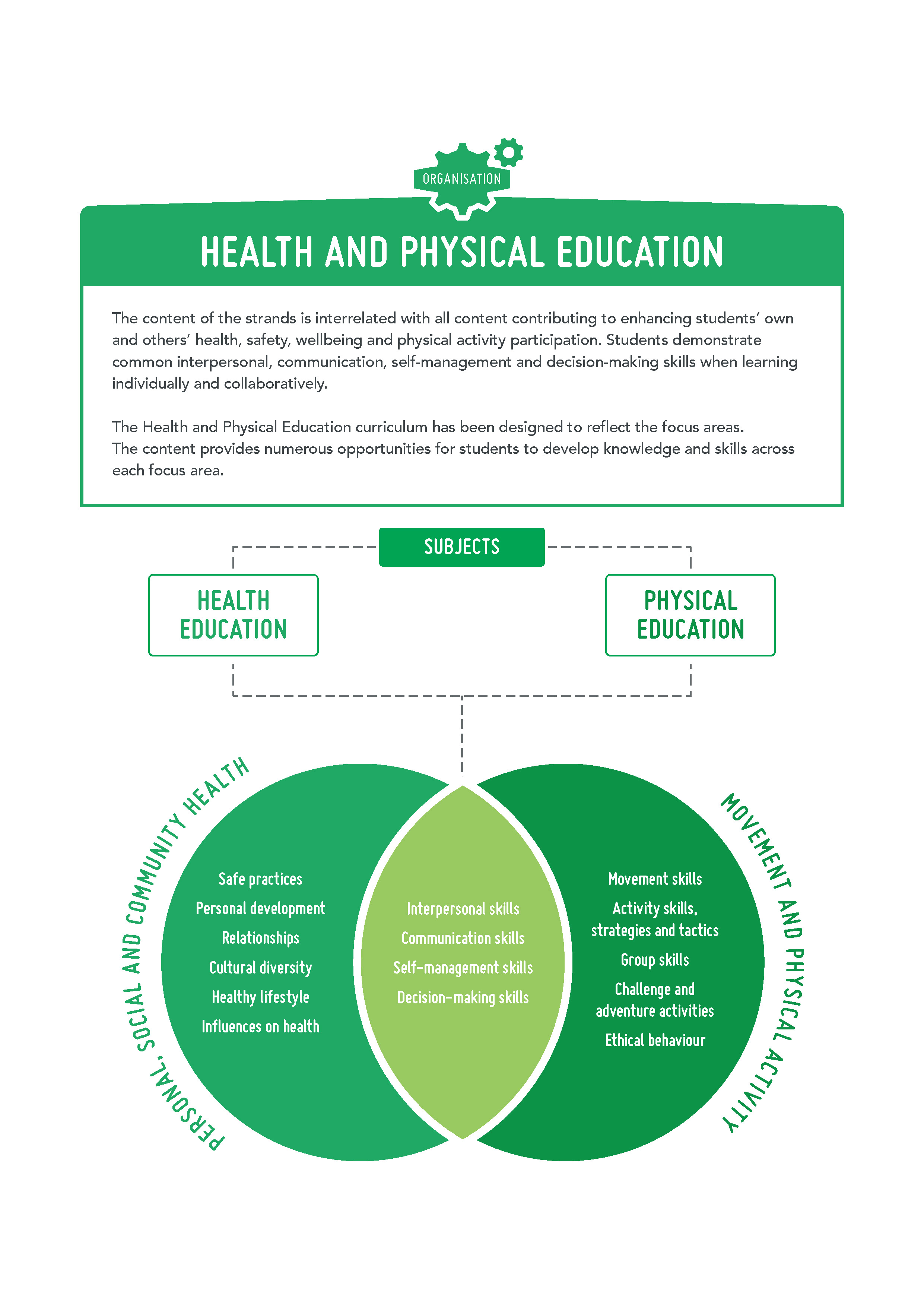Organisation
Content structure
The Health and Physical Education curriculum comprises two strands: Personal, social and community health;and Movement and physical activity. The content in each strand is organised under three interrelated sub-strands.
Personal, social and community health
- Being healthy, safe and active
The content focuses on supporting students to make decisions about their own health, safety and wellbeing. The content develops the knowledge, understanding and skills to support students to be resilient. It also enables them to access and understand health information and empowers them to make healthy, safe and active choices. In addition, the content explores personal identities and emotions, and the contextual factors that influence students' health, safety and wellbeing. Students also learn about the behavioural aspects related to regular physical activity and develop the dispositions required to be an active individual.
- Communicating and interacting for health and wellbeing
The content develops knowledge, understanding and skills to enable students to critically engage with a range of health focus areas and issues. It also helps them apply new information to changing circumstances and environments that influence their own and others' health, safety and wellbeing.
- Contributing to healthy and active communities
The content develops knowledge, understanding and skills to enable students to critically analyse contextual factors that influence the health and wellbeing of communities. The content supports students to selectively access information, products, services and environments to take action to promote the health and wellbeing of their communities.
Movement and physical activity
- Moving our body
The content lays the important early foundations of play and fundamental movement skills. It focuses on the acquisition and refinement of a broad range of movement skills. Students apply movement concepts and strategies to enhance performance. They practise and rehearse skills and strategies to move with competence and confidence. Students develop skills and dispositions necessary for lifelong participation in physical activity, outdoor recreation and sport.
- Understanding movement
The content focuses on developing knowledge and understanding about how and why our body moves and what happens to our body when it moves. While participating in physical activities, students analyse and evaluate theories, techniques and strategies that can be used to understand and enhance the quality of movement and physical activity performance. They explore the place and meaning of physical activity, outdoor recreation and sport in their own and others' lives, and across time and cultures.
- Learning through movement
The content focuses on personal and social skills that can be developed through participation in movement and physical activities. These skills include communication, decision-making, problem-solving, critical and creative thinking, and cooperation. The skills can be developed as students work individually and in small groups or teams to perform movement tasks or solve movement challenges. Through movement experiences, students develop other important personal and social skills such as self-awareness, self-management, persisting with challenges and striving for enhanced performance. They also experience the varied roles within a range of physically active pursuits.
The interrelated nature of the content of the Health and Physical Education curriculum provides opportunities for students to develop interpersonal, communication, self-management, and decision-making skills.
Figure 1 identifies these interrelated skills in Health and Physical Education

|
| Figure 1: The organisation of content in the Health and Physical Education curriculum |
Attitudes and values
The Health and Physical Education curriculum provides opportunities for students to develop positive attitudes and values about their own health and wellbeing, as well as respect for the rights and values of others. Through structured learning experiences, students examine their own attitudes and values and the level of influence they have on their own and others' health. Although attitudes and values are not specified in the syllabus content, students learn to reflect on their own and others' attitudes and values, and consider how they impact on behaviour.
Focus areas
Focus areas indicate breadth of learning across P–10 and provide a context for student engagement with the content. A variety of focus areas should be used to teach the content in each year of schooling, and provide students with a breadth of learning that can be applied in their daily lives.
The focus areas are:
- alcohol and other drugs
- food and nutrition
- health benefits of physical activity
- mental health and wellbeing
- relationships and sexuality
- safety
- active and minor games
- challenge and adventure activities
- fundamental movement skills
- games and sports
- lifelong physical activities
- rhythmic and expressive activities.
Year level descriptions
Year level descriptions provide an overview of the core content being studied at that year level. They also emphasise the interrelated nature of the two strands and the expectation that planning will involve integration of content from across the strands.
Content descriptions
Content descriptions set out the knowledge, understandings and skills that teachers are expected to teach and students are expected to learn. They do not prescribe approaches to teaching. The core content has been written to ensure that learning is appropriately ordered and that unnecessary repetition is avoided. However, a concept or skill introduced at one year level may be revisited, strengthened or extended at later year levels as needed.
Additional content descriptions are available for teachers to incorporate in their teaching programs. Schools will determine the inclusion of additional content, taking into account learning area time allocation and school priorities.
The additional content will not be reflected in the Achievement Standard.
Achievement standards
From Pre-primary to Year 10, achievement standards indicate the quality of learning that students should typically demonstrate by a particular point in their schooling. An achievement standard describes the quality of learning (e.g. the depth of conceptual understanding and the sophistication of skills) that would indicate the student is well-placed to commence the learning required at the next level of achievement.
Glossary
A glossary is provided to support a common understanding of key terms and concepts included in the core content.

 HPE P–10 Scope and Sequence for teaching in 2024
HPE P–10 Scope and Sequence for teaching in 2024